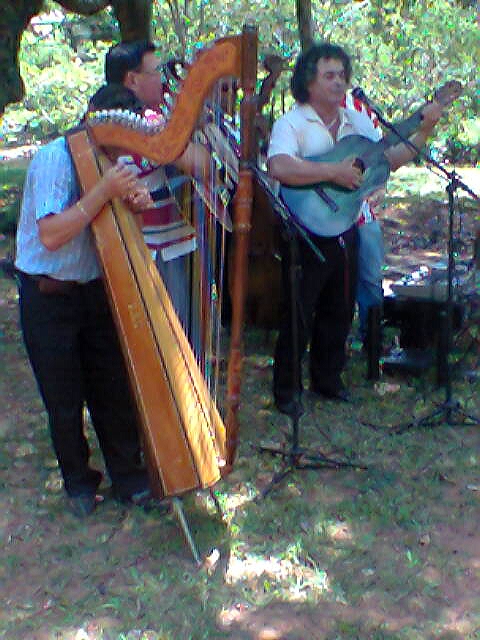The harp is the national instrument of Paraguay. Although it can be found at smart cultural events its real home is the countryside accompanying the bands of musicians that are to be found throughout the land.
A traditional Paraguayan band is built around the harp which is accompanied by a guitar or two. The tunes played will either be well know ones or compositions of the musicians. Either way the music will be unwritten, passed orally from player to player. All across Paraguay in every town and village there are harpist still proudly preforming this most Paraguayan of sounds.
The harp itself came over with the Spanish. It was introduced to the local Guarani Indians by both the Franciscan Friars and the Jesuit Missionaries who found the local population to have a natural flair for music. The Jesuits in particular who collected together wandering bands of Indians into planned religious settlements encouraged the locals to develop their musical skills along with other skills such as stonemasonary as part of their mission to bring Christianity to the peoples of the New World.
One result of this is that Paraguayan music and instruments all have Old World rather than New World origins. The Guarani took to the harp with such enthusiasm that when the Jesuits were finally expelled from the Spanish territories many Guaranis took their harps with them when they returned to live once more in the forests.
In the forests the style and sound of the harp was able to develop into one that was distinctly Paraguayan. At the same time the harp to its place as the sound of traditional Paraguay.
The Paraguayan harp is made of wood and stands about 5 feet tall. It is light enough to be carried by its owner and rugged enough to survive being transported around the countryside from village to village and from fiesta to fiesta. The number of strings can vary from 32 to 46, but a 36 string harp is the most common style. These strings in common with other South American harps are strung from the side of the head. and tuned by keys which are traditionally hand carved, although these days machine made keys have mostly replaced to hand carved ones.
The harp itself is generally made of Palo Santo wood. Wood from a native tree that is ideally suited for carving. The strings themselves used to be made of catgut, but these days nylon strings are the norm.
In playing the harp the strings are not delicately plucked but are instead vigorously strummed with the fingernails. These gives the Paraguayan Harp a lively sound. Hands are placed right hand up, left hand down with the thumbs used to strum the bass notes.
I have on many occasions heard the harp played out here in the countryside by musicians who clearly get great pleasure from their music and the sight of a harp is always a sign enjoyable entertainment to come.


Recent Comments